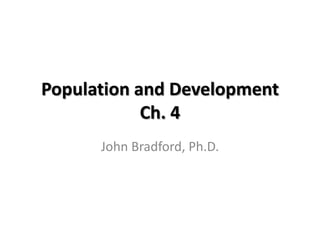
Population, Development, and Environmental Impact
- 1. Population and Development Ch. 4 John Bradford, Ph.D.
- 2. I. Population and Development
- 3. Is the planet over-populated?
- 4. The IPAT model 3 main causes or “drivers” of environmental destruction include: 1) Population- how many people there are 2) Consumption/Production (aka “Affluence”)- how much each person consumes 3) Technology- how efficient the production process is that creates consumer items I = P * A * T, or, Impact = Population x Affluence x Technology.
- 5. The IPAT model I = P * A * T, or, Impact = Population x Affluence x Technology. Affluence is often measured as economic growth, or GDP per capita: GDP/population Technology can be measured as energy intensity, or energy used per unit of GDP growth: energy/GDP Implications: all factors play a role, and we can mitigate environmental damage in 3 ways, but focusing on only one won't suffice!.
- 6. IPAT: Population Three opinions regarding the relation of population and society can be distinguished (Homer-Dixon 1999): 1) Limits to Growth (aka Neo-Malthusians) Believe that resource scarcities place strict limits on population growth, and exceeding these limits may result in social chaos. 2) No Limits to Growth (aka Economic Optimists) Believe there are no limits to population growth because the free market provides incentives for conservation and technological innovation 3) Distributionists Believe that the most significant problem is a maldistribution of wealth and resources
- 7. IPAT: Affluence and Technology Treadmill of Production Main idea: Ecological degradation is a necessary consequence of societal expansion. Ecological Modernization Main idea: economic prosperity and ecological well- being are compatible.
- 8. Thomas Malthus and ‘Over-Population’ • Contrary to popular opinion [including your book!], Malthus did not argue that the world would become over- populated. • Instead, he argued that there is a constant equilibrium of food and population, but that population grows exponentially (1, 2, 4, 8, 16…), whereas food grows only arithmetically (1, 2, 3, 4, 5…). • He provided no empirical evidence for this argument. Thomas Malthus (1766 – 1834)
- 9. Thomas Malthus and ‘Over-Population’ • For Malthus, there is no such thing as over-population! ‘Over’ what? Population cannot exceed food supply. • Instead, Malthus argued that population was always already checked, or limited, by food production. • For Malthus, these ‘checks’ to population took the form of poverty, sickness, plagues, and even famine.
- 10. Thomas Malthus and ‘Over-Population’ • Summary: Malthus argues that food scarcity poverty. • Therefore, he argues, we cannot (and should not) try to help the poor. • Helping the poor is doomed to failure.
- 11. Thomas Malthus and ‘Over-Population’ • “We cannot, in the nature of things … assist the poor, in any way, without enabling them to rear up to manhood a greater number of their children” • “the infant is, comparatively speaking, of no value to the society…”
- 12. Inequality Perspective • Arguments – The world doesn’t lack food. What causes famines is lack of access to food. (Amartya Sen) – No correlation between population density (or also cropland per capita) and famine. – (Japan and Netherlands vs. most countries in Africa, for example) • Rebuttals – Not all cropland is equally productive! – Must take into account annual grain production per capita, aka environmental productivity.
- 13. Demographic Transition “Development is the best contraceptive”? • Stage 1: high birth rates, high mortality rates. • Stage 2: high birth rates, but low mortality rates • Stage 3: low birth rates, low mortality rates.
- 14. Ecological Modernization Theory Ecological Kuznets Curve- economic development and environmental degradation are positively correlated at first, and then negatively correlated after a threshold of development is reached
- 15. Criticisms of Ecological Modernization Theory 1. Data were cross-sectional: A snapshot at a point in time of multiple countries does not tell us anything about the trajectory over time of a single country. 2. EMT doesn't distinguish between an institutional reaction to a problem, and the effect of that reaction on the problem itself, i.e. whether it ‘modernization’ mitigates environmental degradation. 3. EMT relies on case studies that can't be generalized to other countries, or all types of ecological degradation and pollutants (e.g. CO2) 4. Netherlands Fallacy- the error of assuming that national environmental impacts are contained within national borders 5. Jevons paradox: efficiency improvements don't outpace growth
- 16. Globalization and colonialism • According to Bunker and Cicantell (2006), geography colonial globalization. • Competition among colonial powers required them to produce at economies of scale; acquiring the needed raw materials (with a non-random geographical distribution), however, required geographical expansion (or “diseconomies of space”)
